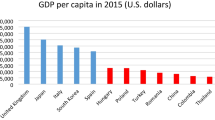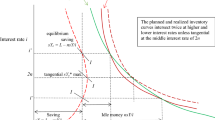Abstract
This paper provides estimates of sectoral price–cost margin (PCM) trends in thirteen OECD countries over the last three decades, once controlled for inflation and cycle effects. It concludes with the absence of a decrease in average PCM. More strikingly, it establishes a clear pattern of PCM convergence both across countries and sectors. This convergence means that high margins have shrunk and low margins grown. Better capital market efficiency might be a driving force in the PCM convergence. These results point to a need to search for factors countervailing the pro-competitive effect on markups.






Similar content being viewed by others
References
Badinger H (2004) Do we really know that the EU’s single market programme has fostered competition? Testing for a decrease in markup ratios in EU industries. Euroapinstitut, Working paper 55
Banerjee A, Russell B (2001) The relationship between the markup and inflation in the G7 economies and Australia. Rev Econ Stat 83(2):377–387
Bernard AB, Eaton J, Jensen JB, Kortum S (2003) Plants and productivity in international trade. Am Econ Rev 93(4):1268–1290
Bils M (1987) The cyclical behaviour of marginal cost and price. Am Econ Rev 77:838–855
Blanchard O (1997) The medium run. Brookings Pap Econ Act 2:89–158
Bliss CJ (1999) Galton’s fallacy and economic convergence. Oxf Econ Pap 51(1):4–14
Boone J (2000) Competition. CEPR discussion paper 2636
Bottasso A, Sembenelli A (2001) Market power, productivity and the EU single market program: evidence from a panel of Italian firms. Eur Econ Rev 45:167–186
Boulhol H (2006) The upward bias of markups estimated from the price-based methodology. Université Paris I, Working Paper Team 0555
Broda C, Weinstein DE (2006) Globalization and the gains from variety. Q J Econ 121(2):541–585
Christiano LJ, Eichenbaum M, Evans CL (1997) Sticky price and limited participation models of money: a comparison. Eur Econ Rev 41(6):1201–1249
Davies S (2001) The evolution of market concentration between 87 and 97. Chapter 5.1. In: Determinants of industrial concentration, market integration and efficiency in the European Union. Final report, DG-EcFin B99/A7050/001
Demirguç-Kunt A, Levine R (1996) Stock market development and financial intermediaries: stylized facts. World Bank Policy Research Working Paper 1462
Domowitz I, Hubbard RG, Petersen BC (1986) Business cycles and the relationship between concentration and price–cost margins. Rand J Econ 17(1):1–17
Evans MD, Hnatkovska V (2006) International capital flows, returns and world financial integration. Society for Economic Dynamics, Meeting paper 60
Hall RE (1986) Market structure and macroeconomic fluctuations. Brookings Pap Econ Act 2:285–322
Hoekman B, Kee HL, Olarreaga M (2001) Mark-ups, entry regulation and trade: does country size matter? CEPR Discussion paper 2853
Katics MM, Petersen BC (1994) The effect of rising import competition on market power: a panel data study of US manufacturing. J Ind Econ 42(3):227–286
Klette TJ (1999) Market power, scale economies and productivity: estimates from a panel of establishment data. J Ind Econ 4:451–476
Melitz MJ, Ottaviano GIP (2005) Market size, trade, and productivity. NBER WP 11393
Oliveira Martins J, Scarpetta S (2002) Estimation of the cyclical behaviour of mark-ups: a technical note. OECD Econ Stud 34:173–188
Oliveira Martins J, Scarpetta S, Pilat D (1996) Mark-up ratios in manufacturing industries: estimates for 14 OECD countries. OECD Working Paper 162
Quah D (1993) Galton’s fallacy and tests of economic convergence. Scand J Econ 95(4):427–443
Roeger W (1995) Can imperfect competition explain the difference between primal and dual productivity measures? Estimates for U.S. manufacturing. J Polit Econ 103(2):316–330
Sauner-Leroy JB (2003) The impact of the implementation of the single market programme on productive efficiency and on mark-ups in the European Union manufacturing industry. European Economy, Economic Papers 192
Schmalensee R (1989) Inter-industry studies of structure and performance. In: Handbook of International Organisation, vol 2, pp 951–1009. Elsevier, Amsterdam
Sutton J (1991) Sunk costs and market structure. MIT Press, Cambridge, MA
Sutton J (1997) Technology and market structure. MIT Press, Cambridge, MA
Tybout JR (1996) Chile, 1979–86: trade liberalization and its aftermath. In: Roberts MJ, Tybout JR (eds) Industrial evolution in developing countries. Oxford University Press, Oxford
Tybout JR (2003) Plant- and firm-level evidence on “new” trade theories. In: Harrigan J, Choi EK (eds) Handbook of international economics. Blackwell, Oxford
UNCTAD (2006) World investment report 2006, Chapter 1. United Nations Conference on Trade and Development, Geneva, Switzerland
Acknowledgement
I am grateful to Lionel Fontagné, Sébastien Jean and Joaquim Oliveira Martins. I would also like to thank Patrick Artus, Gregory Corcos, Matthieu Crozet, Keith Head, Giuseppe Nicoletti, the participants of the TEAM, DELTA and OECD seminars and one anonymous referee for their comments, and Pierre Cahuc, David Galvin, Pamina Koenig and Daniel Mirza for their help.
Author information
Authors and Affiliations
Corresponding author
Additional information
The views expressed in this paper are those of the author and do not necessarily represent those of the OECD or its member countries.
Appendix
Appendix
1.1 Impacts of inflation and cycles
Price changes and observed PCMs are estimated to be negatively linked: a decrease in inflationary pressures induces larger (observed) PCMs, as in Blanchard (1997). This is consistent with price stickiness forcing firms to cut their margins in the face of unfavourable cost developments. However, the variable DEFL is significant for only five of the 13 countries at the 5% level, which is likely to be due to the correlation with oil price variables over the period. When it is significant, it implies that a decrease of 10 points in the GDP deflator, not uncommon since 1980, leads to an increase in observed PCMs between 1 and 2 points. Moreover, the two oil price variables are jointly very significant. Oil price changes between 1980 and the end period entail, beyond the DEFL impact, an average increase of 0.008 in observed PCMs for all countries, ranging from −0.007 for the UK—the only negative point—to 0.040 for Japan, very dependent on oil. Overall, disinflation between 1980 and 2000 has triggered an average transitory increase in PCMs of 0.015 across countries.
At the sectoral level, the EMPCYC estimates confirm the counter-cyclicality of markups, supported empirically by Bils (1987) and Oliveira Martins and Scarpetta (2002) among others. On average per country, the effect of EMPCYC is counter-cyclical for ten countries, being significant for nine of them at the 90% confidence level. Overall, a cycle materialising in an increase of 1% above trend in sectoral employment induces a decrease of 0.0008 in PCMs. On the other hand, the estimated impact of the macroeconomic cycle, through the GAP variable clearly leans towards the pro-cyclicality of markups. This may be due to some externality in demand and is consistent with the observed pro-cyclicality of accounting profits. From the latter observation, scepticism about the counter-cyclicality of markups is implied in Christiano et al. (1997). On balance, these estimates may provide an explanation for why the debate concerning the cyclicality of markups remains unresolved. There may be a supply-driven counter-cyclical partial equilibrium effect dampened by a pro-cyclical general equilibrium one. On average across countries, an increase in the output gap of 1 point of GDP results in an average increase in PCMs of 0.002/0.003. Although the average sensitivity is three times larger than the EMPCYC one, employment at the sector level could fluctuate much more than at the country level.
Rights and permissions
About this article
Cite this article
Boulhol, H. The Convergence of Price–cost Margins. Open Econ Rev 19, 221–240 (2008). https://doi.org/10.1007/s11079-007-9011-2
Published:
Issue Date:
DOI: https://doi.org/10.1007/s11079-007-9011-2




